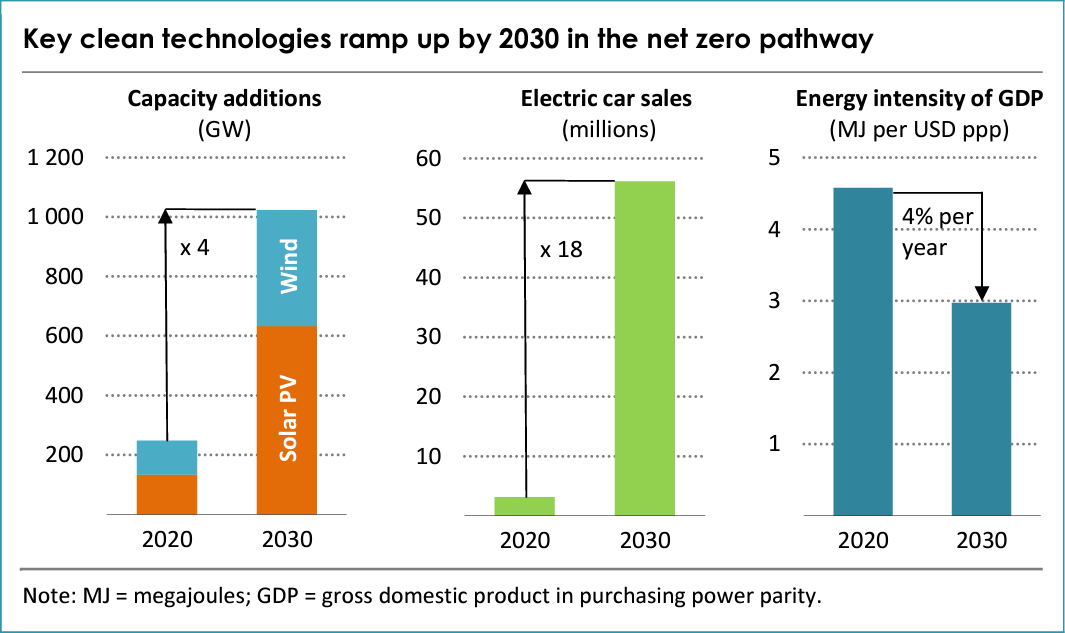
Renewable Energy and Storage Solutions – Optimistic Predictions for the Upcoming Decades
As the clock ticks towards 2050, the global energy landscape is undergoing its most transformative shift yet. As the echoes of environmental urgency grow louder, the International Energy Agency (IEA) presents a comprehensive roadmap, charting a course to a net zero world by 2050. This isn't just a vision; it's a call to action, demanding unparalleled collaboration, innovation, and commitment from every corner of the globe. Dive deep into this energy evolution, where renewable sources reign supreme, traditional fossil fuels fade into the past, and a brighter, sustainable future beckons.
8 min read
In this Article:
- Unpacking the significance of the “Net Zero by 2050: A Roadmap for the Global Energy System” report.
- The massive growth of solar and wind energy as core renewable sources.
Introduction
In an era defined by climate change concerns, ambitious carbon neutrality goals, and a pressing need to reinvent our energy systems, the International Energy Agency’s (IEA) seminal report titled “Net Zero by 2050: A Roadmap for the Global Energy System” stands as a beacon of guidance. The report isn’t just another compilation of data and forecasts; it represents a detailed, comprehensive study, mapping out the vast transformation required over the next three decades to ensure a sustainable energy future for the planet.
With its release, the IEA has provided us with a meticulously researched blueprint that encompasses multiple facets of the energy landscape. It delves into the current trajectory of energy consumption, the anticipated shift in energy production methods, and the evolution required in energy storage and distribution systems. Furthermore, the report serves as an underlining testament to humanity’s collective intent, underscoring how nations and industries are pivoting, at varying degrees, towards a carbon-neutral paradigm.
As we stand at the precipice of what could be the most significant transformation of the global energy system, this introduction seeks to navigate the breadth and depth of the IEA’s findings. Our aim is to distill its core insights, highlight the potential challenges, and present a coherent picture of the dynamic interplay between policy, technology, economics, and society in achieving the ambitious, yet indispensable goal of a net-zero emission world by 2050. The findings of this report are not just of interest to policymakers and industry leaders but are crucial for every global citizen, as the energy transition will indubitably shape our shared future, influencing everything from geopolitics to our daily lives.
This first article in our series will focus predominantly on the ascendancy of renewable energy sources, particularly solar and wind, and their rapid deployment on an unprecedented scale. Additionally, we’ll delve into the pivotal role of advanced energy storage solutions, exploring how cutting-edge battery technologies are primed to stabilize and support the influx of renewable energy in the global grid. Join us as we unravel the intricate tapestry of our future energy framework, as outlined by the IEA.
The Rise of Renewable Energy
In the pantheon of energy sources vying to power the future, renewable energy—primarily solar and wind—has emerged not merely as an alternative, but rather as a dominant force poised to reshape the global energy landscape. Their rise, propelled by a unique amalgamation of technological advancements, economic viability, and environmental imperatives, underscores a remarkable transition from the peripheries of the energy discourse to its very epicenter.
Unprecedented Deployment of Solar and Wind
Over the past few decades, solar and wind energy have moved from experimental ventures to full-blown, scalable industries. According to the IEA’s report, this trend is set to accelerate at a staggering rate in the coming years. By 2030, annual additions are forecasted to reach 630 gigawatts (GW) for solar PV and 390 GW for wind. To put this into perspective, this means that solar installations in 2030 would be equivalent to setting up the world’s current largest solar park every single day. This unprecedented deployment is driven not only by the falling costs of technology but also by the growing realization of the environmental and economic benefits of renewable sources.
Source: https://www.iea.org/reports/net-zero-by-2050
Solar Energy to Reign
The sun, an age-old symbol of life and energy, is set to reclaim its throne in the energy universe. The IEA’s projections indicate that by 2050, solar energy will account for a whopping one-fifth of total global energy supplies, effectively making it the ‘king of energy.’ This supremacy is not merely a function of its abundance but a testament to the rapid strides made in solar technology, policy frameworks, and deployment mechanisms.
To dive deeper into the numbers, solar PV capacity is projected to undergo a colossal 20-fold expansion by 2050. Several factors contribute to this monumental growth:
Technological Advancements: Continuous innovations in photovoltaic materials, panel designs, and manufacturing processes have progressively enhanced the efficiency and reduced the costs of solar panels, making them more accessible and attractive for widespread deployment.
Economic Viability: The declining costs of solar installations, coupled with growing economies of scale, have made solar energy not just competitive but often cheaper than fossil fuel-based sources in many regions. This cost-competitiveness, combined with potential returns on investment, makes solar a compelling proposition for both public and private sectors.
Environmental Imperatives: As the world grapples with the challenges of climate change, the inherently clean nature of solar energy—with zero emissions during operation—positions it as a linchpin in global efforts to reduce carbon footprints.
Decentralization and Energy Security: The modular nature of solar installations allows for decentralized energy generation, providing nations with a means to enhance energy security, reduce transmission losses, and empower communities by democratizing energy access.
In conclusion, the trajectory of renewable energy, spearheaded by solar and wind, heralds a new epoch in the annals of global energy. It signals a shift from an era dominated by fossil fuels and their associated challenges to a future illuminated by the clean, sustainable, and boundless energy of the sun and the wind. The seeds of this transformation have been sown, and as the IEA’s report underscores, the next few decades will be pivotal in determining the shape and substance of this renewable renaissance.
Advanced Energy Storage Solutions
As we usher in an era dominated by renewable energy sources, the intermittency of wind and solar presents a significant challenge. Their inconsistent nature calls for robust storage solutions, central to which are advanced battery technologies. These batteries will play a pivotal role in ensuring a stable, reliable, and continuous energy supply.
Importance of Advanced Battery Technologies
Technological Advancements: The realm of battery technology has seen rapid strides in recent years. Moving beyond traditional lithium-ion solutions, we now have innovations such as solid-state, lithium-sulfur, and flow batteries. These newer forms offer increased energy densities, extended life cycles, and improved safety standards.
Enhancing Grid Stability: Renewable energy, though sustainable, can be unpredictable. Here, batteries serve a dual purpose: absorbing excess energy during periods of high renewable output and releasing it when production dips. This buffering ability is essential to prevent grid overloads and maintain a continuous power supply.
Economic Advantages: Advanced batteries allow for energy storage when production costs are low, with the option to release during high-demand periods. This capability makes renewable projects more economically feasible by balancing demand and supply costs.
Supporting Vehicle Electrification: Beyond their role in power grids, advanced batteries are fundamental to the electric vehicle (EV) industry. Enhanced energy storage capacities lead to longer driving ranges and reduced charging times, pushing EVs closer to replacing conventional vehicles.
 Source: https://www.iea.org/reports/net-zero-by-2050
Source: https://www.iea.org/reports/net-zero-by-2050
Stabilizing the Renewable Energy Supply
Pairing renewables with advanced battery technologies ensures a balanced energy ecosystem. As renewables become mainstream:
Frequency Regulation: Batteries can quickly counteract frequency fluctuations caused by renewables, helping maintain grid stability.
Peak Shaving & Load Leveling: Batteries can manage periods of high demand, reducing strain on power plants and preventing the need for peak energy imports. Simultaneously, they help maintain a consistent demand on power plants for optimal operations.
Integrating Multiple Sources: As the energy mix becomes more diverse, batteries will be instrumental in ensuring different sources work in harmony for efficient energy consumption.
In conclusion, as highlighted by the IEA report, advanced battery technologies are the linchpin in the transition to renewable energy. They ensure that renewable sources are not just sustainable but also reliable, bridging the gap between energy production and consumption in a world moving towards net-zero emissions.
Conclusion
The transition to renewable energy, marked prominently by the accelerated adoption of solar and wind energy, is not just an environmental imperative but also a testament to human ingenuity and adaptability. Alongside this, the evolution of advanced energy storage solutions is essential, ensuring that our burgeoning green energy ecosystem remains both reliable and consistent. As we’ve drawn insights from the IEA’s foundational “Net Zero by 2050” report, it’s evident that these are merely the initial chapters of a broader energy transformation story. Stay tuned for our next article, where we’ll delve deeper into the global shift towards electrification, infrastructure and smart grid advancements, and the role of emerging technologies in shaping our future energy landscape.




